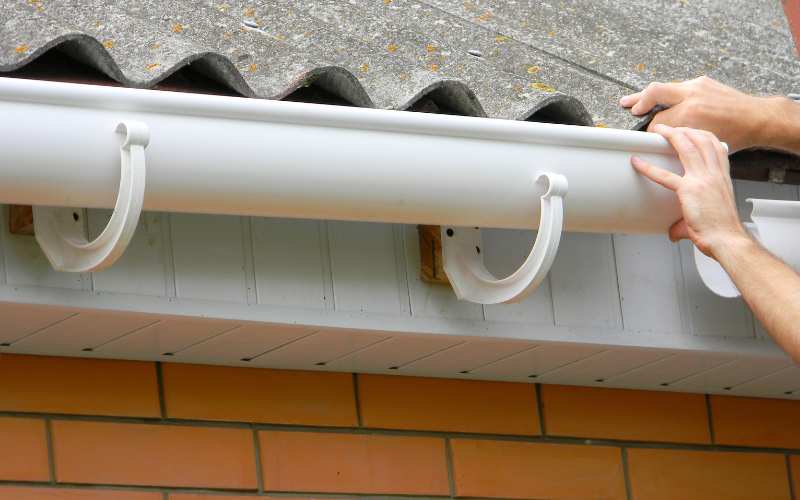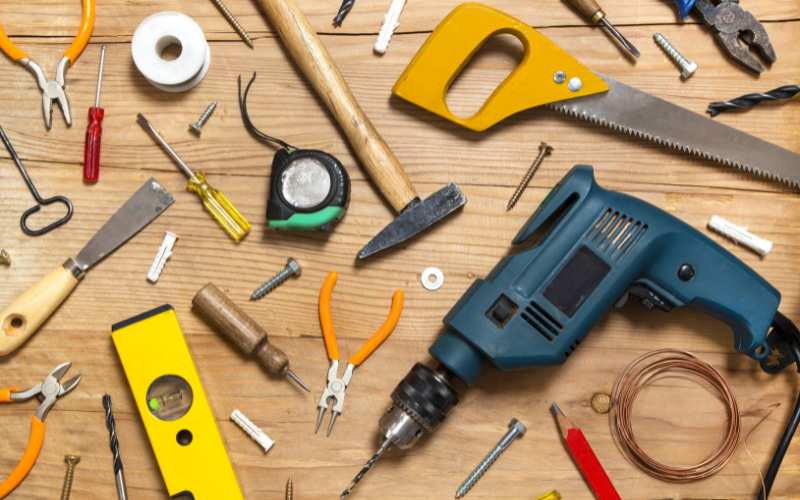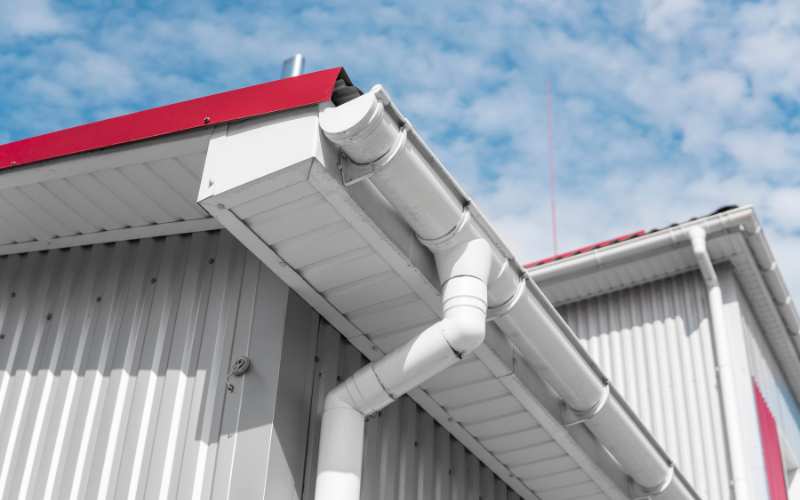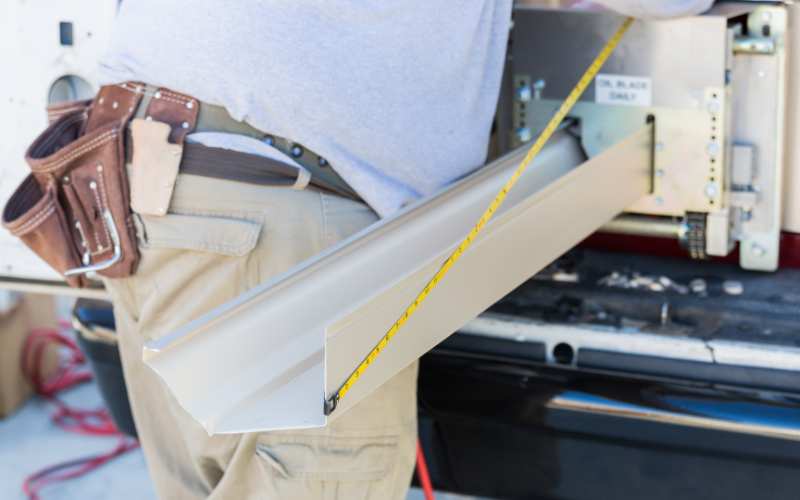
Vinyl gutters are a great way to add curb appeal and increase the value of your home. But most homeowners don’t know how to install vinyl gutters in the right way to their homes. The installation process is not too complicated, but it can be intimidating for homeowners who have never done this before. This step-by-step guide will walk you through the process and save you time, money, and frustration. In this complete blog post, you’ll learn how you can install your own vinyl gutters, from start to finish.
You’ll learn what materials you need for the job, how to prepare your home for gutter installation, and how to measure and cut the gutters. We’ll also cover some important considerations when choosing a gutter style, shape, color, and material. In case you do not have any previous prion experience in installing gutters we recommend calling professional gutter installers to help you. If you’re up for the challenge and have some DIY skills, then keep reading to learn how you can install your own vinyl gutters.
Tools You’ll Need To Install Vinyl Gutters.

- Ladder
- Ruler
- Pencil
- Drop downspout
- Chalk line
- Line level
- Tape measure
- Vinyl hanging brackets
- Screws
- Screwdriver
- Gutter connectors
- Gutter end caps
- Gutters
- Miter saw
- Sandpaper
- 45-degree elbows
- Downspout pipes
- Downspout hangers
- Downspout couplers
What Are Vinyl Gutters?

Vinyl gutters are the latest in gutter systems. This new type of gutter is designed to look like your traditional aluminum or copper gutters, but with increased durability while reducing installation time and labor costs. Vinyl gutters are constructed out of PVC plastic. These gutter types are generally made up of two separate components that snap together for easy installation. These components can be attached without using tools or extra hardware, which allows you to finish your gutter installation faster than with other brands.
What are the Benefits of Vinyl Gutters?
Durability
The first benefit of vinyl gutters is durability. These gutters are made of quality material that can stand up to some very harsh elements over time, including ice buildup and extremely cold temperatures. Additionally, the thicker profile of vinyl makes it possible to install more vents in your system for increased water flow.
Lower maintenance
Vinyl gutters have a low-maintenance design that makes them a great choice for homeowners who want gutters but don’t have the time or skills to install them. These gutter systems do not require any painting and can be easily cleaned using a regular garden hose. Water Flow – Vinyl gutters are designed to allow water to flow freely through your system. If you use a vinyl gutter system, you may need to call a professional gutter cleaner less often than if you had used another kind of material.
Ease of Installation
Vinyl gutters are easy to install because they are lightweight, flexible, and have a snap-together design that is quick and simple. Since these gutter system types do not require any special tools for installation, anyone can easily DIY their new gutters themselves in about an hour!
Cost
Last, but not least, vinyl gutters are relatively inexpensive. You can find 10-foot sections of vinyl gutters for $5 to $10 each. Since the materials used to build these gutters are very durable and long-lasting, you won’t need to replace your gutter components for many years. And when it does come time for replacements, you can find replacement parts for much less than comparable aluminum or copper gutter systems.
What are the Disadvantages of Vinyl Gutters?
There aren’t too many disadvantages to Vinyl gutters. You just have to make sure that you not using cheap vinyl gutters because that will not last long. Also, since the system is snapped together it does mean that you can’t adjust or repair your gutter mid-installation so make sure you plan ahead!
Environmentally Questionable
Since vinyl gutters are actually made from PVC plastic, they aren’t the most environmentally-friendly system out there. Plastic is far more durable, but it’s also environmentally damaging, and not too friendly to wildlife or backyard habitats.
PVC is not biodegradable, and some researchers believe it may leach hazardous chemicals into the water. Vinyl gutters also require more energy to manufacture and transport than aluminum, which again, has a negative impact on the environment. So, if you are an environmental concern person this may not be the system for you.
Limited Style Options
One of the main disadvantages of vinyl gutters is that they are not available in as many style options as other gutter types. Since these gutters are made up of two separate components, you can choose different heights and sizes, but there are more limited design options for your gutter system compared to other types of gutters.
Installation Issues
Vinyl gutters can prove challenging for some homeowners because their installation process requires snap-fit assembly. The multiple parts required for installation can be confusing if you’ve never installed vinyl gutters before, so it’s best to use a guide during installation for the best results!
How to Install Vinyl Gutters

Determine Where You Want The Water to Drain
The first step is to determine where the water will drain from your home. You may either buy a rain barrel and connect it to your gutters to allow the water collected in the barrels to drain into them.
Alternatively, you can build a spillway that diverts water far enough away from your home’s foundation to avoid leaking concerns. It’s critical to settle this out before beginning since it will shape the structure of your gutter system. Where you want to install your gutters will depend on how many downspouts are on the exterior of your property, as well as how much roof coverage you have.
Measure The Gutter Run
Use a ruler or rope to measure the total gutter run of your roof. You need to know this measurement so you can buy enough gutters for your house, but make sure to allow for any bends in the system if it is not straight.
Order Gutter Material Take your measurements and order new vinyl gutters with these numbers for the best results. Remember that you can order more than one section at a time to save on shipping costs!
Position Downspout Extensions
Identify the location of the gutter system drains so that you can position downspout extensions at this spot. This will allow the gutters to drain directly into the right location for optimal performance.
Assemble Your Gutter System
Snap together gutter sections and place them in position so that the underside of each section is positioned over your downspouts. Downspout extensions should attach easily to the bottom.
Hang the Gutter Sections
Use the hangers you just installed to hold the gutter sections in place and then attach them together with a plastic slip joint. After that, you’ll connect each section’s end to the one next to it using a plastic slip joint. Add a cap to any regions that won’t have outlets so that water doesn’t run down toward the downspout.
Attach The Drainpipes to Your Home
To attach the downspout outlet to the gutter, use a cordless drill. Connect the downspouts’ elbows to the outlet and tube that comes from the gutter, then fasten the downspout outlet to the gutter. Make sure these connections are tight; otherwise, you could wind up with a drainage system leak later on.
Install Gutter Covers and a Rain Barrel
Gutter covers can be installed using screws. The downspouts need to attach to the rain barrel with a flexible hose. A hole needs to be cut into the rain barrel for this tubing to fit through, and then the downspout’s elbow should fit snugly into both pieces of tubing. After that, you can connect the drainpipe from the gutter to your rain barrel using a slip joint.
Finish Up With Hooks
Finally, you can attach the gutters using twist-in hooks. Place these on any flat areas of the top of the gutter system, and place them about every three feet for best results.
Some Of The Most Asked Questions Related to Vinyl Gutters

How Much Does It Cost To Install Vinyl (PVC) Gutters?
You can expect to pay about $4-$8 for every linear foot of gutter, which means installing vinyl gutters for a 1,500-square-foot home would cost you roughly $8000-$10500. This includes materials and labor costs.
How long do vinyl gutters last?
The length of time your vinyl gutters will survive is determined by a variety of factors, including where you reside and how you maintain them. Vinyl gutters can last up to 20 years in dry locations with routine maintenance and installation.
Gutters will last a shorter amount of time if you reside in a humid location. Depending on how well you maintain them, vinyl gutters can last anywhere from 8 to 10 years in these locations.
Are Vinyl Gutters Good In Heat Weather?
Vinyl gutters can do well in heat weather when installed properly. Heat will bend the vinyl, however, so you should allow adequate spacing and support for proper airflow and drainage around your gutters. Prolonged exposure to high temperatures can warp or melt your gutters, too.
Can You Paint Vinyl Gutters?
No, painting on vinyl gutters is not recommended. The paint will flake off and clog the pores of the gutter. Vinyl gutters are designed with tiny pores so water can move through the gutter. When paint builds up in these pores, it reduces the ability of the gutter to drain water, which causes overflows. The paint will also discolor the vinyl gutters.
How to Clean Vinyl Gutters?
Vinyl gutters should be cleaned every three months. You can clean your vinyl gutters using a brush or squeegee along with soapy water to rinse them. To ensure you aren’t missing any spots, do this task while standing on a ladder, and be sure to clean all parts of your gutters.
